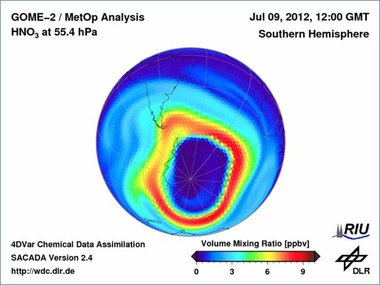|
2012’s ozone hole season starts July 11, 2012-As an annually recurring phenomenon the Antarctic ozone hole is a dramatic illustration of how people change Earth’s atmosphere, thereby threatening life on the surface. The so-called ozone layer is to be found at about 20 to 30 km altitude. It forms a natural protective screen against the dangerous ultraviolet radiation in sunlight. Its thickness can be reduced dramatically by the weather in the upper atmosphere, and also by chemical processes. Since the 1970s it has been known that substances released by human activity can damage the stratospheric ozone layer. Especially the chlorine compounds commonly found in coolants and fire extinguishers have turned out to be destroyers of ozone. To keep the ozone hole from expanding (small holes are also appearing in springtime increasingly over northern Europe), those countries which signed the Montreal Protocol in 1987agreed to prohibit the use of substances which damage the ozone layer. Since the atmosphere is an extremely slowly reacting system, it took until the late 1990s for the ozone hole to reach its maximal extent, despite the ban. These July days, chemical processes have already started to prepare the way for the dramatic disintegration of the ozone layer over the Antarctic which will become visible in September and October.
Analysis of the amount of nitric acid (HNO3) in the stratosphere, based on satellite measurements from GOME-2 instruments and model calculations The figure shows the current
distribution of nitric acid at 20 km altitude on 9 July 2012, as estimated by
scientists at DLR’s German Remote Sensing Data Center based on satellite data. A
large dark blue area with a very low gas concentration can be clearly noted over
the Antarctic. It marks the position of the south polar vortex, an enormous
cyclone over the South Pole. Here the temperatures are so low in winter that
nitric acid droplets and ice particles can form, thereby removing nitrogen
radicals from the chemical reactor of the stratosphere. This weakens the natural
“immune system” of the atmosphere because nitrogen radicals can neutralize the
chlorine released by human activity into the atmosphere and in this way hinder
the destruction of ozone, which starts as the sun rises. In the deep blue area
the ozone is already helplessly at the mercy of the springtime sunshine.
Presumably, there will be a large ozone hole also this year. Together with the Association of German Dermatologists, DLR operates a UV alert service which gives practical advice about how long skin of a given type can tolerate exposure to the sun Dr. Frank Baier German Aerospace Center (DLR) German Remote Sensing Data Center, Atmosphere Weßling |




